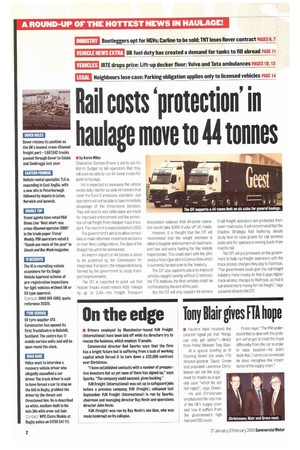Rail costs ' protection in haulage move to 44 tonnes •
Page 4

If you've noticed an error in this article please click here to report it so we can fix it.
by Karen Mies Chancellor Gordon Brown is Set to use his March Budget to tell operators that they will soon be able to run 44-tonne trucks for general haulage.
He is expected to announce the vehicle excise duty rate for six-axle 44-tonners that meet the Euro-2 emissions standard—but operators will not be able to take immediate advantage of the three-tonne increase. They will have to wait while plans are made for improved enforcement and the protection of rail freight from cheaper road transport. The new limit is expected before 2003.
The government's aim is to allow companies to make informed investment decisions cn their fleet configurations. The date of the Budget has yet to be announced.
An interim report on 44 tonnes is about to be published by the Commission for Integrated Transport, the independent body formed by the government to study transport improvements.
The CIT is expected to point out that heavier trucks would reduce HGV mileage by up to 2.4%—the Freight Transport
Association believes that 44-tonne operation would take 9,000 trucks off UK roads.
However, it is thought that the CIT will recommend that the weight increase is allied to tougher enforcement of road transport law and extra funding for the Vehicle Inspectorate. This could start with the 24m surplus from Operator's Licence fees which is currently handed over to the Treasury.
The CIT also supports plans to impound vehicles caught running without 0-licences: the ETA believes the first vehicles could be confiscated by the end of this year.
But the CIT will only support 44-tonners if rail-freight operators are protected from lower road costs. It will recommend that the Shadow Strategic Rail Authority should study how to raise grants for rail terminal costs and for operators moving loads from road to rail.
The CIT will put pressure on the government to help rail-freight operators with the track access charges they pay to Flailtrack. "The government could gve the rail-freight industry more money so that it pays higher track access charges to Railtrack, so that it can invest more money for rail freight." says a source close to the CIT.












































































































